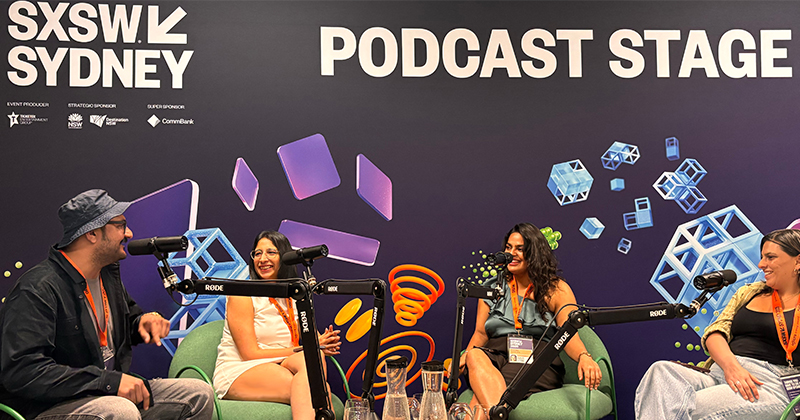The Evolution of South Asian Music is a two part podcast series hosted by Akhila Shankar, a music executive and co host of the Indian Music Charts podcast, and Roochay Shukla, a music marketeer working across global artist development. Recorded live at SXSW Sydney 2025, the series examines how South Asian music is moving from a regional category to a global cultural force, driven by shifts in listening behaviour, diaspora identity and the changing role of digital platforms.
Across both episodes, the hosts track how audiences in India are influencing global charts, how diaspora communities are reshaping the definition of South Asianness, and why a growing number of international artists are finding traction across the subcontinent.
The conversations are joined by two guests who work at the intersection of culture, digital behaviour and artist growth:
• Jade Nazareth, artist manager for Australian singer songwriter Matthew Ifield, whose largest audience base sits in India.
• Jashima, brand consultant and founder of Ode, a multicultural marketing and talent agency focused on amplifying South Asian voices globally.
Redefining a Region Through Its Sound
The series opens by challenging a long held industry assumption. There is no singular South Asian sound. Instead, the region functions through multiple coexisting ecosystems: film and non film releases, regional language markets, long standing folk traditions, and independent movements across hip hop, R&B, electronic music and pop. Each ecosystem scales differently, yet all contribute to the region’s cultural footprint.
Who Shapes the Definition Today
Akhila and Roochay explore how the definition of South Asian music shifts depending on geography. Domestic audiences, diaspora communities and global listeners often frame the music differently. As Jashima notes, diaspora listeners do not approach South Asian music as niche or category based. Their relationship is shaped by identity, community and cultural continuity rather than genre labels.
Discovery Patterns Across Borders
Several consistent discovery behaviours emerge across platforms:
• Short form video remains a fast track to initial visibility.
• YouTube continues to operate as one of the most powerful engines for South Asian music worldwide.
• Regional language content travels across continents through diaspora networks, creating new pockets of demand.
Case Study: Matthew Ifield’s Audience in India
Jade outlines how Matthew Ifield’s audience in India developed organically long before any touring plans. Early spikes on streaming platforms, paired with concentrated engagement on YouTube, positioned India as his lead market. The example underscores a broader trend: international artists are increasingly building their strongest early audiences in places the industry once considered peripheral.
India’s Market Realities and a Shifting Live Landscape
Akhila breaks down India’s chart behaviour across 2024 and early 2025. Film music remains a dominant force, but its share has declined enough to make space for non film pop. Hip hop continues to index higher on Apple Music. Malayalam music features prominently due to the breakout of a single film project.
Streaming Does Not Always Predict Live Demand
India’s live ecosystem operates on a separate logic.
• Rock and metal have seen renewed momentum via festival circuits and legacy touring.
• Electronic music continues to scale through franchises such as DGTL and Anjunadeep.
• Hip hop is positioned for a significant year with Rolling Loud entering India.
• Pop, although strong digitally, is still building stable large format touring models.
The Scale of India’s College Circuit
One of the most striking insights from Part Two is the size of India’s college festival ecosystem. With an estimated 350 to 400 college festivals annually, and roughly 75 multi day events from the country’s top institutes alone, this circuit operates as a parallel touring economy. It shapes early fandom and genre discovery in ways streaming metrics cannot fully reflect.
Growth Outside the Metros
Tier 2 and Tier 3 cities continue to accelerate live growth. Markets such as Lucknow, Indore and Jaipur have become key destinations for ticketed shows. India hosted an estimated 30,000 live events in the past year, much of it outside major metros.
Digital Entry Before Touring
The conversations highlight a practical pathway for international artists: build an Indian audience digitally before touring. With 550 million monthly active users, YouTube remains India’s most influential discovery platform.
Tactics discussed include:
• using Shorts for reach and long form video for depth
• releasing multilingual versions or culturally contextual covers
• active engagement in comment sections to identify early audience pockets
Jade describes how prompts such as “Who is listening from India” helped map communities, which later became WhatsApp fan groups that informed touring strategy.
Authenticity as a Long Term Strategy
A consistent theme across the two episodes is that artists who approach India as a long term relationship tend to build more resilient audiences. The example of Lauv’s early engagement with Indian creators and fans demonstrates how authenticity outperforms short term opportunism.
A Region in Constant Motion
Viewed together, the two episodes document a region expanding on several fronts simultaneously. South Asian music is not moving toward a single global identity. Instead, it is being shaped by diaspora culture, digital behaviour, regional diversity and a fast growing live economy. The contradictions between what streams, what travels and what sells tickets are not weaknesses but signals of a market in transition.
South Asia is no longer positioned at the edges of global music culture. It is increasingly one of the forces reshaping it, audience by audience and market by market.










